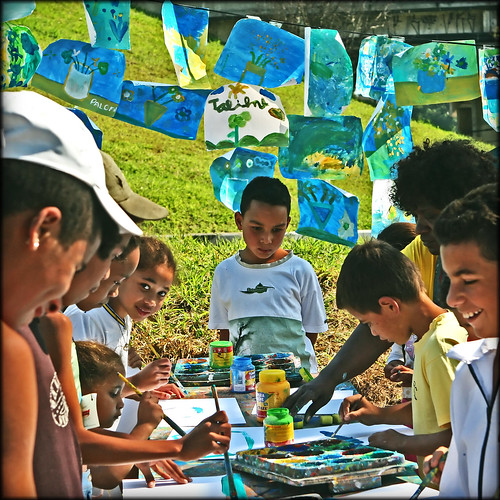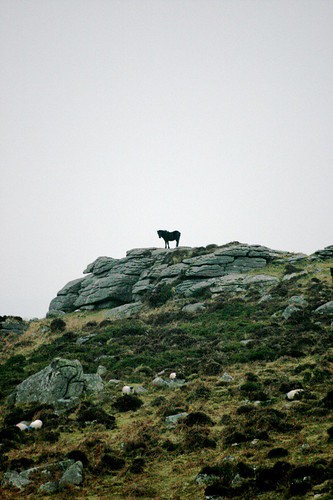From Steve who has a great eye for interesting things. Thanks, Steve! These cause me delight, wonder, joy and and a deep gratitude towards human creativity.
Year: 2009
Reminder: St. Paddy’s and Chocolate Guinness Cake
 It was such a hit last year, I’m gearing up to bake a Chocolate Guinness Cake again. As a public service, I’m reblogging the recipe link!
It was such a hit last year, I’m gearing up to bake a Chocolate Guinness Cake again. As a public service, I’m reblogging the recipe link!
So it is off to the kitchen! Remember, if you are like this White House, we like to add shredded coconut to the recipe.
Chris Corrigan – 3 Lessons on Leadership
 Chris Corrigan shares three lessons he learned about leadership while doing work this week with Aboriginal leaders in Canada. This is good stuff. I rarely quote this much, but I sense this is stuff that has value far and wide for all of us. It resonates with the groundswell I hear, feel and read about concerning our need for each other, for community, in turbulent times. And how we take responsibility matters, regardless of label of “leader.” Thanks, Chris.
Chris Corrigan shares three lessons he learned about leadership while doing work this week with Aboriginal leaders in Canada. This is good stuff. I rarely quote this much, but I sense this is stuff that has value far and wide for all of us. It resonates with the groundswell I hear, feel and read about concerning our need for each other, for community, in turbulent times. And how we take responsibility matters, regardless of label of “leader.” Thanks, Chris.
Teaching one came from Nancy Jones one of the Elders who gave us small blankets with a medicine wheel design based on a vision that she had about unity, leadership and healing. One of the great teachings in this medicine wheel was about the north, the direction from which winter weather and wind comes. We laboured here through a blizzard today, waiting for an hour until whoever was coming was going to show up, and working small processes with diminished numbers. But the Elder gave the teaching that essentially the weather teaches us that “whatever happens is the only thing that could have” and that the chaordic path is an inherent part of leadership: you can never really be in control.
The second teaching was from Ralph Johnson. I asked him about the Ojibway word “ogiimaw” which is often translated as “chief” or “boss.” I asked Ralph what he thought the word must have meant before contact, when the concept of “chief” was basically unknown. He said that word relates to the word ogiimatik which is the poplar tree, the tree that is considered the kindest of trees. Poplars are gentle, flexible, quiet and kind and are also good medicine. He said this idea of kindness is what is under the word “ogiimaw” and that influencing people through kindness is the kind of leadership that the word implies. This is very different from the kinds of leadership implied by the word “chief” which is a title now won by competition in a band election, a process that seems to engineer kindness right out of the equation. This is a great legacy of colonization – the lowering of kindness from a high leadership art to a naive sentimentality.
Ralph also gave me one more little teaching that rocked me. He told me that the word I had always understood as “all my relations” – dineamaaganik – actually means “belonging to everything.” Seems like a small change in translation, until another Elder, Marie Allen chimed in and said that the problem with leadership these days was the way ideas like “all my relations” activated the ego. The difference between “all my relations” and “belonging to everything” is the difference between the ego and the egoless I think. This is what Ralph was trying to tell me. That the centre of the universe is not me, and things are not all related to me, rather I belong to everything. Marie and I took a moment to express amazement at the way the earth used us to channel life in a particular shape for a short period of time. We come from her, we return to her, and in the interim we do our work upon her.
CoP Series #7: Roles and Scalability
 This is the seventh in a series of blog posts I wrote for Darren Sidnick. I am finally getting the rest of the series up. Part 1, part 2, part 3,, part 4, part 5, part 6, part 7 , part 8 , part 9 and part 1o are all here on the blog.)
This is the seventh in a series of blog posts I wrote for Darren Sidnick. I am finally getting the rest of the series up. Part 1, part 2, part 3,, part 4, part 5, part 6, part 7 , part 8 , part 9 and part 1o are all here on the blog.)
In the last post in this series we talked about some of the roles that support successful learning communities and CoPs (Communities of Practice). But when we think of these roles in the context of organizations like the e-learning provider UFI Learndirect (for whom this series was originally written), whose strength is providing learning services at a massive scale, some natural tensions are going to emerge. We might say “yeah, all these roles are nice, but there is no way to provide them a scale.”
How can we creatively thinking about scalability of roles? What might be the interaction between paid, formalized roles provided by Learndirect and the cultivation of roles within a learning cohort or an ongoing community? How might technology help us? Let’s look at some options.
- Within courses/intense support – assessment, content, and tutoring. Tutors with both content and pedagogical experience help students assess learning needs and pull together relevant resources (at Ufi learndirect, the pedagogy and much of the tutor support is in-built within the e-learning couse). They are a “first line” of support with explicit boundaries on what they can do. This may be more or less needed depending on the course. Some content lends itself to being a solo student experience with little support. Others are more complex and need more support. Technology may assist to direct relevant content to the right learners through diagnostic paths (a la Amazon’s recommendation system) on the assessment side.
 Across “course” offerings/building community support –community cultivation, connecting learners. While there might not be able to be an intense level of support at an individual cohort level, can there be learning communities that draw from multiple cohorts for the same course? For example, I may be taking a self paced module on childcare for infants. Within that course, there is no “community” per se, but I can log into the “Infant Childcare” community and ask questions of peers and experts, get access to more content and come back when I have questions about what I’ve learned in application. This might be seen as a set of domain specific portals. This offers the ability for both tutor and peer support on a more scalable level than at the course level (another way could be to take a generic course like numeracy or employability and build a niche community around say financial management that is a key issue for some of the learners. The same principle could work for leadership and management and many other more generi courses). All this can augment the automated diagnostics with a community of people who might have more diverse or contextual recommendations. Developing good critical thinking to evaluate and assess recommendations – automated or human, may be something important to foster within the community(ies.)
Across “course” offerings/building community support –community cultivation, connecting learners. While there might not be able to be an intense level of support at an individual cohort level, can there be learning communities that draw from multiple cohorts for the same course? For example, I may be taking a self paced module on childcare for infants. Within that course, there is no “community” per se, but I can log into the “Infant Childcare” community and ask questions of peers and experts, get access to more content and come back when I have questions about what I’ve learned in application. This might be seen as a set of domain specific portals. This offers the ability for both tutor and peer support on a more scalable level than at the course level (another way could be to take a generic course like numeracy or employability and build a niche community around say financial management that is a key issue for some of the learners. The same principle could work for leadership and management and many other more generi courses). All this can augment the automated diagnostics with a community of people who might have more diverse or contextual recommendations. Developing good critical thinking to evaluate and assess recommendations – automated or human, may be something important to foster within the community(ies.)- Learning support from the “wider world” – tapping into networks, professional associations and local organisations. An important learning bridge is that place between the formality of a “course” and the ongoing application of learning in the world. This ongoing learning is primarily informal. We can link students to external supports for their ongoing learning. It may be professional associations, guilds, communities of practice or local organizations. Linking learners to these ongoing support not only bridges to application, but it may also attract people from the community who wish to participate in domain communities sponsored by the learning institution, offering value in both directions.
The bottom line is that support roles are neither fixed, nor limited to paid, internal resources. If we look at the value chain across this ecosystem, each layer, each player has something to offer and something to gain through cooperating.
Resources:
- http://learningcircuits.blogspot.com/2006/06/roles-in-cops.html
- http://www.joe.org/joe/2008august/a1.shtml
Images:
Between disagreement and cynicism
 (I wrote this in January – never finished, nor published it. I’m cleaning out some blog drafts and it felt worthwhile to try and tidy this one up and get it out. )
(I wrote this in January – never finished, nor published it. I’m cleaning out some blog drafts and it felt worthwhile to try and tidy this one up and get it out. )
As I chew over my learnings of the past week in Rome for the Share Fair and work at IFAD (the International Fund for Agricultural Development, another UN Agency), one lesson I clearly needed to learn was the boundary between edge of disagreement and the pit of cynicism. As a facilitator, I am often accused of abusing political correctness, or even of being a Pollyanna. In my advocacy of communities, I have been cautioned about the negative influence of groupthink and the erosion of tolerance for diversity.
I often think of these admonitions as reactions reflecting past negative experiences of something. “I had a group exclude me, therefore groups are more about who is out than who is in.” Or “the politically correct forget the value of critical thinking.” I have always struggled to respond to these comments because they are always correct – some of the time. There are counter examples in every case, and counter patterns. Everything has a dark and a light side, so our generalizations are as damaging as they are helpful.
My only way to cope with this is to try and practice a set of principles that work to promote as generative and useful contexts for working as I can. But heck, like everyone else, I fail. All the time. I abuse my own values.
I noticed one situation last week that really stuck out for me. I was getting very frustrated with the planning process of the Share Fair over the last few months. I felt a sense of fear to really live into the spirit of knowledge sharing. A protection of organizational rather than collective values as five organizations collaborated to create the event, and the oppressive weight of political formality that is embedded in some of the organizations. I even got petulant and threatened to not come. Uh oh.
But I flew to Rome. I was frustrated that the sessions I was to facilitate were labeled as “discussions” – faint cover for “traditional panel sessions,” and that I was assigned a technical session I knew little about. In short, I found a lot to complain about and expected little. Uh oh.
When did I slip from disagreement to cynicism? How could I then let my cynicism dampen or even hurt others who were trying their best to make a positive outcome? One of the lead facilitators, who was overburdened not just with the Fair, but with other work and the typical string of mishaps outside of work, said something to the effect that she had chosen optimism as her approach in the face of challenges.
Where is the line between constructive disagreement and engagement and the heavy dampening of cynicism? How do we continue to push forward and not fall back to old habits, work with all the negativity, and still retain a sense of possibility and optimism? And why is this so important?
During the Fair, sure, there were a lot of cool things we could have done. Did they go as far as they could have? In many cases, no. But did they go far ENOUGH? There was a palpable sense of learning permeating so many of the sessions. There were people huddled in conversation in the booths and over coffee. (I have to say, I’m SO happy that the decision to have a dedicated coffee/food bar IN the actual event area was preserved. I can’t say enough of the magical power of food and good Italian coffee to convene knowledge sharing moments.) So what if the opening was stiff and formal. What about the excitement of participants in the blogging session who said “NOW I know what blogging is all about.” Or the colleagues from different organizations who sat together in a panel discussion and discovered important intersections in their work.
In our aspirations to make something the best it can be, we can be blinded by the “rightness” of our own ideas. So, they might be right. But they are not the only possibility. Big ships turn slowly, but the people on them can still be individually and collectively nimble. Cynicism dampens the human spirit. Constructive and positive (in attitude and spirit) disagreement can stimulate innovation and growth. We should no more keep quiet with new ideas just because they are disruptive than we should condem others because they don’t see nor appreciate our divergent ideas.
I was in a conversation with one of the responsible staff for the fair. I was chastizing him and his organization for not taking the leap of leadership into experimentation for positive change. I said people were being too safe.
He looked at me, an outside consultant, and said “thats what we hire you for.”
If this is true, then my role as external agent of disruption must continue to offer divergent perspectives, but not fall into the trap of cynicism. Then my value disappears.
Photo: Uploaded on January 18, 2009 by Laura Whitehead